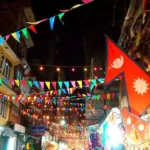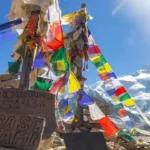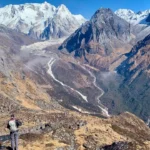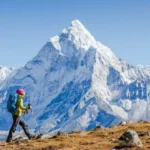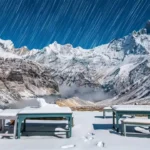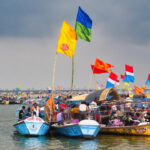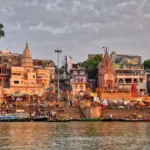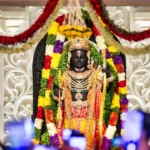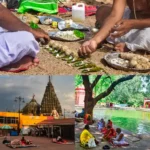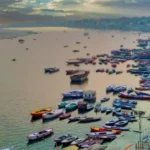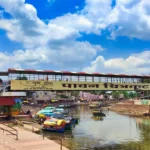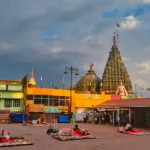Local Festivals and Traditions
Festivals in Mustang aren’t just colourful celebrations—they’re spiritual lifelines that have been passed down for generations. Rooted in Tibetan Buddhism, these events bring entire communities together in vibrant displays of ritual, dance, music, and mythology. Travellers attending a festival in Mustang is one of the most immersive ways to connect with the region’s Tibetan heritage.
The Tiji Festival – Mustang’s Crown Jewel
Held annually in Lo Manthang, the Tiji Festival is the most famous cultural event in Mustang—and for good reason. “Tiji” stands for “Tenpa Chirim”, meaning “the hope of Buddha’s Dharma prevailing in all worlds.” It’s based on the myth of a deity named Dorje Jono, who defeats a demon threatening Mustang’s existence.
What to Expect:
- Three days of masked dances and rituals, performed by monks in stunning, colourful costumes.
- The main square of Lo Manthang transforms into a sacred stage, where dramatic reenactments of the Dorje Jono legend unfold.
- Locals from surrounding villages trek into town dressed in traditional Tibetan attire, adding even more authenticity and pageantry.
When to Go: The Tiji Festival usually takes place in May, but dates shift based on the Tibetan lunar calendar, so it’s best to check in advance if you want to plan your trip around it.

Other Cultural Celebrations
- Yartung Festival (August): Celebrated with horse races, feasting, and dancing in places like Muktinath and Jomsom. Originally a Tibetan Buddhist festival, it also marks the end of the monsoon and the summer harvest.
- Losar (Tibetan New Year): Celebrated in late January or February. Families gather for prayer ceremonies, cleaning rituals, and traditional meals. It’s more subdued in Mustang than in cities like Kathmandu, but no less meaningful.
Respectful Participation for Travellers
- Always ask before photographing rituals or people, especially monks or elders.
- Dress modestly, and consider wearing local scarves or traditional pieces (available in Lo Manthang) to show appreciation.
- Join in where appropriate—locals often welcome respectful travellers to observe, and sometimes even participate in celebrations.
Experiencing these festivals offers more than just entertainment—it gives you insight into Mustang’s spiritual heart and a deeper connection to its people.
Trekking in Mustang
Trekking in Mustang isn’t just about stunning landscapes—it’s a journey through ancient trade routes, Tibetan villages, and sacred valleys that feel frozen in time. Whether you’re walking beneath sandstone cliffs or sipping butter tea in a high-altitude homestay, every step reveals a story.
Upper Mustang Trek: The Cultural Odyssey
The Upper Mustang Trek is unlike any other in Nepal. It’s not about towering peaks (though you’ll see plenty); it’s about entering a hidden kingdom that was isolated from the world for centuries.
Highlights Include:
- Exploring Lo Manthang, the walled capital
- Visiting ancient monasteries and cave dwellings
- Trekking through arid canyons, wind-eroded cliffs, and dramatic desert landscapes
- Interacting with locals in remote villages like Ghami, Tsarang, and Chhoser
How Long Is the Trek?
Most Upper Mustang treks take 10–14 days, depending on your starting point (usually Jomsom or Kagbeni) and pace. Many itineraries include acclimatisation days and extra time in Lo Manthang to soak in the culture.
Best Time to Trek Mustang
One of the coolest things about Mustang? It’s in a rain shadow, which means you can trek during the monsoon (June–August) when most of Nepal’s trails are a soggy mess.
Top Seasons:
- Spring (March–May) – Great weather, blooming landscapes, and time it right and you’ll catch the Tiji Festival.
- Summer (June–August) – Ideal because it’s dry in Mustang, even when other regions get heavy rain.
- Autumn (September–November) – Crisp skies and amazing light for photography.
Altitude & Difficulty
- Max elevation: ~3,800m (Lo Manthang) – not extreme, but acclimatisation is still important.
- Difficulty: Moderate – trails aren’t technically hard, but the dry air, wind, and high altitude add a challenge.

Do You Need a Guide?
Yes—for Upper Mustang, a licensed guide is mandatory, and you must be in a group of at least two (or pay a supplement). This keeps tourism controlled and helps preserve the region.
Quick Tips for Trekking Mustang
- Pack for both sun and wind – the dry, open landscape means intense UV and whipping gusts.
- Stay hydrated – the altitude is sneaky and dehydration is common.
- Respect local customs – walk clockwise around chortens and prayer walls, and avoid loud music or drones near monasteries.
Tibetan Cuisine and Homestay Culture
Beyond Mustang’s windswept cliffs and ancient temples, there’s something equally powerful waiting for you: the kitchen. Food in Mustang is as much about culture as it is about flavour, and staying in a local homestay means you’re not just observing the region’s Tibetan heritage—you’re living it.
What’s Cooking in Mustang?
The cuisine here is hearty, comforting, and built for the harsh, high-altitude climate. You won’t find fancy menus, but you will get authentic, soul-satisfying meals that locals have been perfecting for centuries.
Must-Try Dishes:
- Thukpa: A warming noodle soup packed with veggies and sometimes yak or goat meat. Perfect after a long trek.
- Momos: Steamed dumplings stuffed with minced meat or vegetables, often served with a fiery chilli dipping sauce.
- Tsampa: Roasted barley flour mixed with tea or yak butter—a staple energy food.
- Butter Tea (Po Cha): Salty, oily, and surprisingly addictive. This tea, made with yak butter, black tea, and salt, helps keep locals warm and hydrated in Mustang’s dry climate.
Most meals are made with locally sourced ingredients—think potatoes, buckwheat, barley, lentils, and a handful of hardy mountain greens.
The Homestay Experience
Staying in a traditional Mustang homestay is a chance to go beyond the trekking trail and step into someone’s world.
What to Expect:
- Simple, cosy rooms, often with thick blankets and yak-wool rugs
- Shared meals in the family kitchen, cooked over a wood-burning stove
- A chance to watch or even help with cooking, weaving, or tending to animals
- Nights spent sipping tea and hearing local stories under a sky full of stars.
Homestays in villages like Tsarang, Ghami, and Lo Manthang are increasingly popular—not just for their charm, but for their role in sustainable tourism. By staying local, you’re directly supporting families and helping preserve Mustang’s culture.

Sustainable and Ethical Travel Tips
- Book homestays through trusted local operators to ensure fair wages and quality experiences.
- Eat local, skip the packaged snacks, and try to avoid plastic waste.
- Be mindful of water use, especially in dry months when water is scarce.
Preserving Tibetan Heritage in Mustang
As one of the last strongholds of authentic Tibetan culture, Mustang faces a unique challenge: how to stay rooted in its ancient traditions while adapting to a rapidly changing world. From climate change to modern development and a growing tourism industry, the region’s cultural identity is at a crossroads.
What’s At Risk?
- Modernisation: As roads expand and technology becomes more accessible, younger generations are gradually drifting away from traditional practices like Buddhist rituals, local dress, and the Tibetan language.
- Cultural Erosion: Tourism, when not managed carefully, can lead to the commercialisation of sacred sites, loss of authenticity, and overexposure of once-protected spaces.
- Climate Change: With glaciers retreating and weather patterns shifting, traditional farming methods and water sources are under serious pressure.
- Outmigration: Many young people leave Mustang for education or jobs in cities, leaving behind a shrinking population in the villages.
Local Efforts to Keep the Culture Alive
Thankfully, strong grassroots and international efforts are working to preserve Mustang’s Tibetan heritage:
- Monastery Restoration Projects: Organisations like the Lo Gyalpo Jigme Foundation and The American Himalayan Foundation have restored key monasteries in Lo Manthang and Tsarang, preserving centuries-old murals and artefacts.
- Cultural Education: Monastic schools and community learning centres teach Tibetan language, dance, and music to local youth, keeping traditions alive.
- Eco-Tourism Initiatives: Local guides and homestay owners are trained to offer authentic yet low-impact experiences that benefit both travellers and the community.
HowTravellerss Can Help
If you’re visiting Mustang, there are several ways you can be part of the solution:
- Choose local – Hire local guides, eat local food, and stay in family-run guesthouses.
- Travel with respect – Ask before taking photos, dress modestly, and observe local customs.
- Offset your impact – Carry reusable bottles, minimize waste, and avoid handing out money or gifts to children, which can unintentionally encourage begging.
- Support conservation efforts – Some trekking operators and NGOS offer the option to donate to cultural preservation projects as part of your trip.
Visiting Mustang isn’t just about seeing—it’s about participating in the preservation of a rare and beautiful way of life.
Planning Your Trip
So you’re ready to explore the ancient trails and timeless culture of Mustang? Here’s what you need to know to make your journey smooth, legal, and unforgettable.
Best Time to Visit Mustang
Thanks to its position in the rain shadow of the Himalayas, Mustang is one of the few places in Nepal where trekking is possible even during the monsoon season.
- Spring (March–May): One of the best times to visit—clear skies, mild temperatures, and blooming wildflowers. Perfect for those wanting to catch the Tiji Festival.
- Summer (June–August): Surprisingly ideal in Mustang! While most of Nepal gets drenched, Mustang stays dry and warm.
- Autumn (September–November): Another great season with crisp air and gorgeous post-monsoon light.
- Winter (December–February): Snowfall can make access tricky, and many locals migrate to lower elevations. It’s very quiet, but harsh.

Permits and Regulations (in Indian Rupees)
Travelling to Upper Mustang isn’t as simple as walking in—you’ll need a few key permits due to its restricted status. Here’s what you need to know, with prices converted to Indian Rupees:
Required Permits
- Restricted Area Permit (RAP)
- Cost: ₹41,500 per person for the first 10 days
- Additional days: ₹4,150 per person/day
- Only issued through registered trekking agencies in Nepal
- Annapurna Conservation Area Permit (ACAP)
- Cost: ₹2,500 per person
- Required whether you’re trekking in Upper or Lower Mustang
- TIMS Card (Trekkers’ Information Management System)
- Often waived if you have the RAP.
- If required: ~₹1,600
Guides & Group Rules
- Licensed Guide Mandatory: Solo travel isn’t allowed in Upper Mustang. You’ll need to travel with at least one other person, or pay an extra “solo surcharge” via your agency.
- Trekking Agency Required: You can’t apply for the permits yourself—your guide or agency will handle everything.
Getting There
- Fly: Pokhara ➝ Jomsom (20–25 min,) then start your trek or drive from there
- Drive: Take a jeep or bus via Beni and Kagbeni—it’s a long, bumpy ride but full of stunning views
- Trek: Most Upper Mustang treks begin in Kagbeni and follow the ancient trade route north to Lo Manthang
Accommodation
- Tea Houses: Basic but cosy guesthouses, common along the trail
- Homestays: Available in several villages for deeper cultural immersion
- Camping: Still an option in more remote routes or for custom treks
Packing Essentials
- Layers: Days can be warm, nights are chilly—even in summer
- Sun protection: High UV exposure in Mustang’s desert-like landscape
- Windproof gear: It gets gusty!
- Refillable water bottle + purifier: Stay hydrated and reduce plastic use
- Camera: You’re going to want to capture everything.










